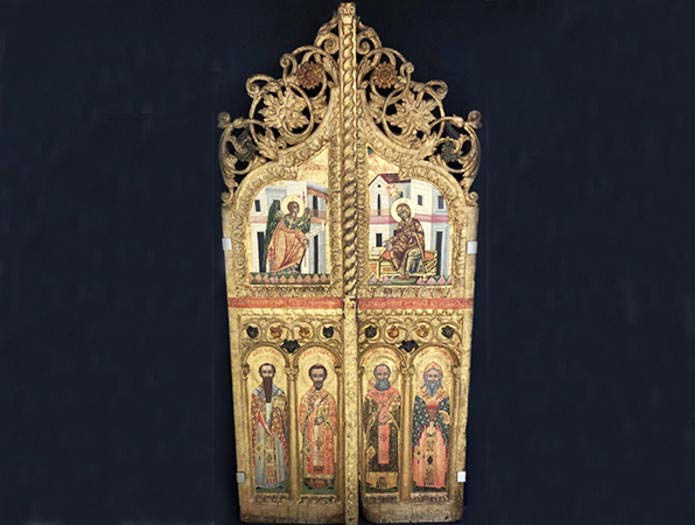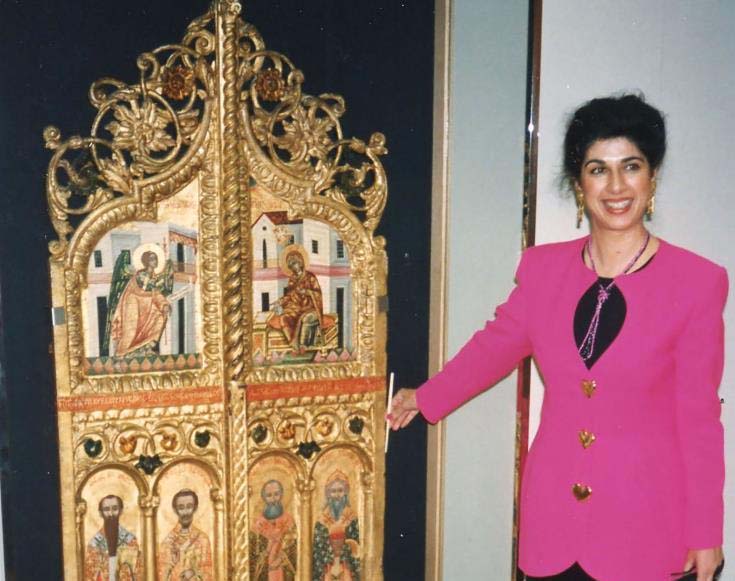The doors of an iconostasis in an occupied Church were reported as having returned home last week. They were the first looted item to be returned to the island from Asia.
Kyriaki Christodoulou details their journey
It took more than 20 years and the involvement of private detectives for a stolen religious artifact to return to the island, with the royal iconostasis doors of Agios Anastasios from Turkish occupied Peristeronopigi village travelling here from Japan, making them the first looted item to have been secured from an Asian country.
The repatriation was announced last week and follows efforts that intensified in the last two years.
The story behind their journey home dates back to the 1990s when they were first spotted at a gallery in the Netherlands by Tasoula Hadjitofi, then Honorary Consul of Cyprus, and well known internationally for her work on repatriating stolen artifacts.
Often called the Icon Hunter, Hadjitofi is best known for orchestrating the Munich Case, one of the largest art trafficking operations in Europe which led to the arrest of the Turkish art smuggler Aydin Dikmen and the confiscation of over $60 million worth of looted artifacts from Cyprus and around the world.
The Royal Doors left Cyprus between 1974 and 1980 as they were exhibited in Wijnburg, Holland, an exhibition which eventually went bankrupt.
“The documents of the bankruptcy were secured by myself in the late 80s after hiring a private detective with my own money,” Hadjitofi said. In the bankruptcy documents there were pictures of the Royal Doors which then director of the Department of Antiquities Thanasis Papageorgiou recognised and confirmed their provenance but Cyprus could not take any action as the whereabouts of the doors were not known.
But in 1991 while walking at the street Hadjitofi saw the doors in a window at the Roozemond Gallery in the Hague and sent somebody to take a picture for Papageorgiou to confirm if those were the Peristeronopiyi Doors.
“In those days we did not have the internet and we worked using a fax machine. Pictures had to be sent by mail and authenticated by notary. Once Papageorgiou confirmed that these were the Royal Doors of Peristeronopiyi, I confronted Robert Roozemond, the owner of the Gallery and requested the Doors verbally and in writing, on behalf of Cyprus. He claimed the Doors belonged to a client and confidentiality and privacy did not allow him to reveal his/her name”.
According to Hadjitofi, documents showed they were bought from Michel van Rijn and Aydin Dikmen, which also proved Dikmen and Roozemond were working together. But the doors vanished from the shop window.
“So once again, Cyprus could not take legal action. Roozemond requested the Cyprus Archbishop to send a more senior diplomat as he did not like to have discussions with me but the Archbishop responded with his full backing for me,” she said.
In 1996 van Rijn demanded a power of attorney from her to negotiate on her behalf over the Royal Doors but once Hadjitofi refused they travelled to Japan together for him to show her where the doors were.
“I flew to Osaka with my husband and met van Rijn who told us the doors were in the Kanazawa College of Art. I had meetings with the lawyers of the College and took the train to actually see the Royal Doors which were in the museum part of the College. The College’s staff and the lawyers explained that the Royal Doors were bought with tax money and from a legitimate gallery in The Hague so how could they have known the Doors were looted. They questioned the records of the Cyprus Antiquities Department which were hand written and with no pictures attached and they wanted much more evidence and pictures of the Doors in the Church, which we did not have”, she said.
After a media campaign in Japan, Holland, Greece and elsewhere in 1999 when Hadjitofi was no longer Honorary Consul, the College in Kanazawa refused to respond to her letters as they did not consider her an official. The then Archbishop confirmed she was the representative of the Church, but they would not recognise the Church either.
According to her story, Hadjitofi then turned to the Japanese television and convinced a producer to make a documentary about looted antiquities of Cyprus and speak about the Royal Doors to pressure the college to give back the doors to the people of Cyprus.
“The documentary was a big success and won an award in Japan so the climate was right for negotiations. But as I was no longer the Consul, the Embassy of Cyprus in the Netherlands took negotiations with the College over but the Japanese insisted they had to get the tax money spent [to buy the doors] back’’, she said.
There followed a lull of almost ten years during which time Hadjitofi set up the Walk of Truth foundation in 2012 and her archives were made available to researchers and academics worldwide. The Royal Doors were discussed in universities and also in her speeches plus in her book The Icon Hunter.
Hadjitofi said that early in 2020 Bishop Vassilios of Constantia informed her that the Director of Antiquities was negotiating with the College to buy back the Doors with money from the Archbishopric.
“I suggested that the government should never engage in negotiations involving public money to buy back looted art and neither should the Church. If the Bishop and the Department of Antiquities would agree to collaborate with Walk of Truth, I told them that the foundation would then find a sponsor, given all legal routes were exhausted and provide a united front towards the Japanese and the outside world.
However the bishop was loathe to create conflict with the antiquities department.
Meanwhile, head of the Office for Combating Illegal Possession and Trafficking of Antiquities in the Cyprus police Michalis Gavrielides told the Cyprus News Agency last week that the strengthening of relations between Cyprus and Japan, with the opening of a Japanese embassy in Nicosia and a Cyprus embassy in Tokyo, played a catalytic role in the outcome of this case.
Cyprus ambassador to Japan Charis Moritsis said the embassy was involved in the case since 2019. The efforts, he said, reached a conclusion with the appropriate discretion and effectiveness.
Τhe Royal Doors by the hand of the Monk Philaretos were completed in 1775. They are of pine wood, adorned with richly illuminated religious panels, and form the centre of the iconostasis.
The Cypriot iconographic tradition of the 18th century is different from the rest of the Orthodox world, of which they are an important example. During this period, the upper part of iconostasis doors were usually decorated with representations of the Annunciation, while the lower parts were often decorated with representations of the Three Hierarchs and occasionally, with a Cypriot saint, Ayios Spyridonas in this case.
The Royal iconostasis Doors will be conserved by the Department of Antiquities and will be handed over to the Archbishopric until their return to the church of Ayios Anastasios, where they belong, is made possible.









Click here to change your cookie preferences